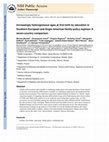Papers by Steve Smallwood
Population Studies-a Journal of Demography, Feb 14, 2020
Having reviewed volume 39 of this series (Smallwood 2017), it seems fitting that I should review ... more Having reviewed volume 39 of this series (Smallwood 2017), it seems fitting that I should review volume 47, also edited by Robert Schoen, in his fourth outing in that role. The topic of this editio...
Trude Lappegård er forsker ved Seksjon for demografi og levekårsforskning i Statistisk sentralbyrå
Population Trends, Sep 1, 2011
It is well documented that the generations born around 1930 are consistently exhibiting higher ra... more It is well documented that the generations born around 1930 are consistently exhibiting higher rates of mortality improvement than the generations either side of them. There is currently no evidence that these differentials are declining. In current ONS National Population Projections, it is assumed that these cohorts will continue to experience higher rates of improvement. However, it is not yet precisely clear why this is so. This article details preliminary research carried out using the ONS Longitudinal Study to try to understand better why the members of the generation born around 1930 have been enjoying higher rates of mortality improvement throughout their adult life.
Palgrave Macmillan UK eBooks, 2005
This chapter explores changes in the age structure of the UK population over the last three decad... more This chapter explores changes in the age structure of the UK population over the last three decades. The ways in which the age profile of the population might change in the future are also discussed. Mid-year population estimates for 2004 are compared with those for ...
PubMed, 2003
One of the key components of national population projections is the assumed level of fertility, w... more One of the key components of national population projections is the assumed level of fertility, which determines the number of future births in the projections. Assumptions are made in terms of the average number of children women will have over their lifetime. For the 2002-based projections this average is assumed to ultimately be 1.75 for England and for Wales, 1.60 for Scotland, and 1.80 for Northern Ireland, leading to a United Kingdom assumption of 1.74. This article explains how these overall assumptions, which are the same as assumed in the 2000-based and interim 2001-based projections, are derived. It also explains why these levels are higher than current 'period' indicators of fertility. Finally, information on more detailed age specific fertility rates, and implications for family size distributions, is given.
PubMed, 2004
This article explores the characteristics of live births where no father was present on the birth... more This article explores the characteristics of live births where no father was present on the birth certificate (sole registrations) using registration data. It then uses data from the ONS Longitudinal Study to examine some characteristics of mothers who have ever experienced a sole registered live birth. It shows that as a proportion of all births, sole registrations have remained fairly constant over the last two decades, although since 1998 there is some evidence of a fall in the proportion. For mothers born between 1955 and 1962 around nine per cent experienced a sole registration. Those who ever experienced a sole registration were around four years younger when they began their childbearing. These women also had larger families and were more likely to come from a lower social class background.
PubMed, 2007
This article explores recent trends in marriage. Following consistent falls in marriage rates in ... more This article explores recent trends in marriage. Following consistent falls in marriage rates in the last quarter of the 20th century the early years of this century have seen some relatively large fluctuations in marriage numbers and rates. This article illustrates some of the recent trends in marriage. One innovation is that it presents marriage data by month, controlled for the effect of peak marriage days in the week. It also discusses a recent legislative change, affecting those subject to immigration control that wish to marry, which may be one of many factors affecting latest marriage trends. Readers should bear in mind that the 2005 data shown in the article are provisional.
PubMed, 2008
Even though cohabitation has become more prevalent in the last few decades, the majority of the a... more Even though cohabitation has become more prevalent in the last few decades, the majority of the adult population is married, and marriage is associated with a number of factors, such as educational outcom and health. Understanding the marrie population is also an important part of understanding partnering behaviour and family formation and dissolution. The length of marriages and whether they are ended by death or divorce is therefore of interest t demographers and policy maker

PubMed, 2002
Changes in the ages at which women give birth to their children mean that fertility measured at a... more Changes in the ages at which women give birth to their children mean that fertility measured at a particular point in time (period) may not be a good representation of the ultimate fertility of those women. The common measure of period fertility is the total fertility rate, which in 2001 has fallen to the lowest level since records began in England and Wales. This article presents various methods that have been proposed to adjust period fertility data to take account of changes in the timing of childbearing, applied to England and Wales data. The article concludes that while these adjustment methods provide useful insights, for example, that the total fertility rate has underestimated period quantum fertility since the 1970s, the measures produced are difficult to interpret. This is in part because the concept they are trying to measure, period quantum is itself imprecise. The adjustments do not necessarily provide a reliable indicator of underlying cohort fertility.
PubMed, 2005
Replacement fertility is a term commonly used by demographers when referring to levels of childbe... more Replacement fertility is a term commonly used by demographers when referring to levels of childbearing and yet is rarely explained. It is normally presented as being around 2.1 children per woman. Continued below replacement fertility in developed countries and fertility falling in developing countries has given the concept of replacement fertility a higher profile. This article explains how replacement level is calculated and explores the concept further. Past replacement fertility levels are calculated for England and Wales. A possible alternative definition of replacement is also presented. Simple projection scenarios are used to show the effect on population of below replacement fertility, and also of postponement of fertility. The importance and implications of below replacement fertility are discussed.
PubMed, 2003
This article presents and analyses women's childbearing intentions collected in the General House... more This article presents and analyses women's childbearing intentions collected in the General Household Survey (GHS). Data from the 21 surveys from 1979 to 2001 show that over that period there has been a fall in women's intended numbers of births. However the latest data (from the 1998, 2000 and 2001 surveys) show that the average number of children intended is still around two, somewhat higher than the average number of children current fertility rates suggest women will have. The questions of whether this difference can be interpreted as possible unmet need for children, whether past intentions have been good predictors of fertility, and how current intentions may be used to inform projections assumptions are discussed. In relation to the last question, fertility intentions by ethnic group are also presented.
PubMed, 2005
Women, on average, live longer than men, though sex differences in mortality vary from country to... more Women, on average, live longer than men, though sex differences in mortality vary from country to country and over time. This study includes a description of recent changes in life expectancies at different ages, followed by a more detailed analysis of death rates by age in selected countries. Additionally it provides a historical perspective on the sex differences in mortality in France and England and Wales. Possible explanations for the differences among countries are explored using trends in mortality by cause of death.
PubMed, 2003
This article examines how strong the association is between the obtaining of higher educational q... more This article examines how strong the association is between the obtaining of higher educational qualifications and later entry to motherhood, and how these are associated with levels and pace of second and subsequent childbearing. Data from the ONS Longitudinal Study are used to estimate these associations for women born in England and Wales between 1954 and 1958. Average age of entry to motherhood is found to be five years later for women with higher qualifications than for those without. Increasing age of motherhood is always associated with a lower likelihood of going on to have another child, but the decline with age is less pronounced for women with a higher qualification. Moreover, for any given age of childbearing, mothers with a higher qualification are more likely than those without to have another child, and are more likely to do so quickly.
Population Trends, Mar 1, 2011
In an increasingly complex society there are a number of different population definitions that ca... more In an increasingly complex society there are a number of different population definitions that can be relevant for users, beyond the standard definition used in counting the population. This article describes the enumeration base for the 2011 Census and how alternative population outputs may be produced. It provides a background as to how the questions on the questionnaire were decided upon and how population bases can be constructed from the Census. Similarities and differences between the information collected across the three UK Censuses (England and Wales, Scotland and Northern Ireland) are discussed. Finally, issues around estimating the population on alternative bases are presented.
Population Studies-a Journal of Demography, Jan 2, 2017
Population Trends, Oct 1, 2010
This article uses data for members of the ONS Longitudinal Study (LS) from both Census 2001 enume... more This article uses data for members of the ONS Longitudinal Study (LS) from both Census 2001 enumeration and patient registrations "frozen" on census day 2001 from the National Health Service Central Register (NHSCR) to examine potential sources of difference in area of usual residence. Overall 95.7 per cent of ONS LS members enumerated at census resided in the same area as recorded on the NHSCR data. Where areas differed, or the ONS LS member was not on the NHSCR on census day, subsequent NHSCR records were examined. Records flagged on the NHSCR as ONS LS members in England and Wales on census day but with no census record were also investigated.
Population Trends, Oct 1, 2010
This article reviews existing procedures employed by various countries in the evaluation of, and/... more This article reviews existing procedures employed by various countries in the evaluation of, and/or adjustment, either of census data, or of population estimates based upon census data. The work was carried out to ensure all potential demographic techniques are considered by the ONS for the post census evaluation process of the 2011 Census.

PubMed, 2005
Progressively later starting of childbearing has been a feature of cohort change in fertility acr... more Progressively later starting of childbearing has been a feature of cohort change in fertility across Europe and elsewhere over recent decades. Growing differences in the age patterns of childbearing between the Anglo-American and continental European countries, however, have also been found. The present study uses large linked-record databases in Britain, France and Norway to analyse these differences in more detail, focussing on age at entry to motherhood (first childbearing) by level of educational attainment among women born in the 1950s and in the 1960s. The shift between these two cohorts towards a later pattern of first childbearing in Britain was confined to women with secondary school qualifications and above. For women born in the 1960s, the peak age for risk of first childbearing among those with secondary school qualifications grew to be between seven and eleven years later than among women without secondary school qualifications. In France and Norway, the peak ages for risk of first childbearing shifted more uniformly across education levels between the two cohorts. For these 1950s and 1960s cohorts, improvements in women's educational levels also occurred more uniformly in France and Norway, moving more women into education categories characterised by later patterns of first childbearing.
You may re-use this publication (excluding logos) free of charge in any format for research, priv... more You may re-use this publication (excluding logos) free of charge in any format for research, private study or internal circulation within an organisation. You must re-use it accurately and not use it in a misleading context. The material must be acknowledged as Crown copyright and you must give the title of the source publication. Where we have identifi ed any third party copyright material you will need to obtain permission from the copyright holders concerned. This publication is also available at the National Statistics website: www.statistics.gov.uk For any other use of this material please apply for a Click-Use Licence for core material at: www.opsi.gov.uk/click-use/system/online/pLogin.asp or by writing to: Offi ce of Public Sector Information

Population Studies, 2010
Family-policy regimes unfavourable to combining employment with motherhood have been claimed to i... more Family-policy regimes unfavourable to combining employment with motherhood have been claimed to increase socioeconomic differentials in fertility as combining employment and motherhood has become more normative. This claim has to date been explored mainly in reference to 'liberal' Anglo-American regimes. Comparing education differentials in age at first birth among native-born women of 1950s and 1960s birth cohorts in seven countries representing three regime types, we find persistence in early first births among low-educated women not only in Britain and the United States but also in Greece, Italy, and Spain. Shifts towards later first births, however, were more extreme in Southern Europe and involved to some extent women at all education levels. The educationallyheterogeneous changes in age patterns of first births seen in the Southern European and Anglo-American family-policy regimes contrast with educationally-homogeneous changes across birth cohorts seen in the study's two 'universalistic' countries, Norway and France.











Uploads
Papers by Steve Smallwood